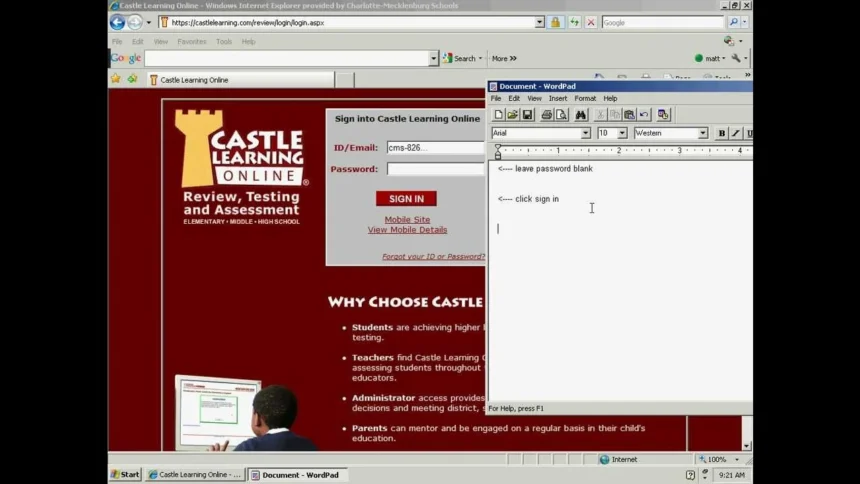In a rapidly evolving education landscape, digital learning platforms that support assessment, practice, feedback, and analytics are more crucial than ever. Castle Learning is one such platform that has been used by thousands of schools, districts, teachers, parents, and students to help strengthen learning outcomes. This guide will dive deep into what Castle Learning is, its features, how to get the best out of it, its limitations, comparisons, and tips for successful implementation.
What Is Castle Learning?
Castle Learning is an instructional support platform / assessment & practice tool used primarily in K-12 education. It helps teachers assign work, assess learning, track progress, provide feedback, and enable differentiated instruction
Founded in 1991, Castle Software, Inc. created it; in August 2019 it was acquired by Harris School Solutions (Harris Education Solutions), to integrate with their education product offerings.
It is headquartered in Depew, New York.
The mission: to provide high-quality content, authored by educators, with data-driven tools so that teachers can focus on instruction and students can show academic growth.
Key Features of Castle Learning
Here are the core features that define Castle Learning and make it useful in educational settings.
1. Large Question Bank Aligned with Standards
- Contains over 170,000 questions aligned to state or Common Core standards, varying in topics, issues, difficulty, etc.
- Questions cover many subjects—Mathematics, English Language Arts, Science, Social Studies, World Languages (such as Spanish, French), electives, etc.
2. Flexible Assignment & Assessment Types
- Teachers can use pre-built assignments (“ready-to-go”) created by the Castle Learning content team.
- Also possible: custom assignments made by teachers, combining topics, levels, different question types.
- Uses multiple formats: multiple choice, true/false, short answer, essay / constructed response, fill-in-blanks, etc.
3. Instant Feedback & Instructional Support
- Students receive immediate scoring on many questions, with hints, explanations (“reasons”), vocabulary links etc. This helps learning by correcting misconceptions immediately.
- Feedback and errors can be reviewed so that students see what they should have done, not just whether they were wrong.
4. Differentiated Instruction & Accessibility Features
- Teachers can tailor assignments for different students: different difficulty levels, accommodations (e.g. text-to-speech, highlighting), mixing of content areas.
- Useful for students learning at different paces, or those needing remediation.
5. Reporting & Data Analytics
- Detailed reports at student, class, and district level: growth over time, mastery of standards, performance across topics, etc.
- Administrators can compare pre-test & post-test, see where students are struggling, adjust pacing or curriculum accordingly.
6. Test Prep & Practice Resources
- Past state assessments and Regents Exams (in states that have them) for review and practice.
- Integration with third-party test prep content such as Method Learning for SAT/ACT preparation.
7. Flexibility, Accessibility, Anytime Access
- Web-based, supports access from any Internet-connected device. Works for homework, self-study, review, etc.
- Available 24/7 so students can work outside school hours; offline / paper-based versions also possible in some cases.
8. Teacher & Administrator Tools
- Teachers can share assignments with colleagues, deploy common assessments across department/school/district.
- Training, support, webinars, video tutorials so that teachers and administrators can maximize the platform’s utility.
How Castle Learning Helps Teachers & Administrators
This section explores how Castle Learning addresses real challenges teachers and administrators face.
Streamlining Assessment Creation & Grading
- Teachers don’t always have to build tests from scratch: use ready-made content or the large question bank.
- Instant grading of objective questions (multiple choice, etc.) saves time.
- Teachers can focus more on instruction, remediation, and engaging students, instead of tedious marking.
Differentiation & Personalized Instruction
- Because students have different strengths and weaknesses, Castle allows tailoring of assignments. Teachers can give extra practice where needed.
- Features like highlighting, text-to-speech, alternate question sets assist students who need special accommodations.
Data-Driven Decision Making
- With growth reports, administrators see where there are gaps in student learning, enabling early interventions.
- Comparisons of baseline vs later assessments, standard/subject/topic performance gives insight into instructional effectiveness.
Supporting Test Preparation & Standards Mastery
- Provides practice for state tests, Regents exams, and standardized tests. This helps reduce test anxiety and improve preparedness.
- Students can generate self-study sessions targeting their weak areas.
Benefits for Students & Parents
From the user/student/parent side, Castle Learning offers concrete advantages.
- Immediate Feedback helps students understand mistakes, correct them, and reinforce learning before misconceptions become entrenched.
- Practice & Mastery: Students can practice until they master topics, not just once then move on.
- Self-Paced Learning: They can work on assignments, self-study, review off class time.
- Parental Visibility: Where enabled, parents can monitor progress, see performance data, help with homework or additional practice.
Implementation & Flexibility: When & How to Use Castle Learning
Here are ways Castle Learning can be used in different educational settings, and what makes it flexible.
- Homework & Daily Practice: Teachers assign nightly work or practice sessions to reinforce lessons.
- Quizzes / Unit Tests / Benchmark Assessments: Can be used formally to check for mastery or readiness for next units.
- Remediation / RTI / MTSS: Used for interventions—students needing extra work on particular standards or topics. Teachers can generate targeted assignments.
- Flipped Classroom: Students can study or review content before class; class time can be used for discussion or deeper work
- Summer Learning / Test Prep: Ideal for bridging gaps during summer, or preparing for standardized or end-of-year exams.
Comparisons: Castle Learning vs Other EdTech / Assessment Tools
To understand where Castle Learning shines (and where it might lag), it helps to compare with similar platforms/tools.
| Criteria | Strengths of Castle Learning | Areas to Consider / Possible Weaknesses |
|---|---|---|
| Content Size & Standards Alignment | Very large question bank, aligned to many state/Common Core standards; many subject areas. | Some newer platforms have more modern UI/UX or gamified experiences. Might feel less “flashy”. |
| Customization & Flexibility | High: custom assignments, mixing content, accommodations, alternative formats. | Teachers may need initial training; some parts may feel rigid or constrained by how the question bank is organized. |
| Feedback & Analytics | Instant feedback, detailed reports; useful analytics for growth tracking. | Depth of analytics is strong, but interpreting data may require training or a support structure. |
| Test Preparation | Good coverage (state tests, Regents, etc.), plus third party integrations. | For very specialized exams or newer standardized formats, some content may be missing or less relevant. |
| Accessibility & Accommodations | Accessibility options like text-to-speech, offline/printable, etc. | Dependent on internet/device access; in under-resourced contexts, technology requirements may be a barrier. |
| Cost / Licensing | It is a paid/licensed product for schools; provides good value where licensure exists. | May be expensive for small schools / districts; home users might not have access unless school provides. |
Limitations & Challenges
While Castle Learning has many strengths, there are also limitations and practical challenges to watch out for.
- Cost & Licensing
- Requires subscription / school-district or building license. Not free for individuals in many cases.
- Budget constraints can limit how many students or teachers can have premium access.
- Technology Dependence
- Requires reliable Internet, compatible devices. In areas with low connectivity or limited devices per student, access can be inconsistent.
- Sometimes platform performance or UI may lag or feel less modern compared to newer apps.
- User Experience / Learning Curve
- Teachers and students new to the platform may need training on features, navigation, reporting tools.
- Some feedback from users is that the interface is less intuitive or “clunky” compared to more modern apps.
- Overemphasis on Standardized Testing
- Because many tools and content are aligned to state standards or standardized test preparation, education might become test-centered rather than holistic.
- Risk that other educational values (creativity, project work, hands-on learning) may be less emphasized if teachers rely too heavily on digital assessments.
- Student Motivation / Engagement
- Doing many assignments online, especially repetitive ones, can lead to fatigue or lack of engagement.
- The platform’s design tends toward practice and assessment; for motivation, teachers may need to supplement with varied, creative tasks.
Best Practices: How to Get the Most Out of Castle Learning
To maximize the impact of Castle Learning, here are some recommendations and tips for teachers, administrators, and students.
- Training & Onboarding: Ensure teachers receive proper training (webinars, workshops) so they understand all features (customization, reporting, accommodations).
- Start with Pilot or Small-Scale Implementation: Try with one grade level or subject before rolling out school-wide, to work out workflows and gather feedback.
- Align with Curriculum & Pacing Guides: Map the platform’s standards/questions to your school or district’s curriculum so assignments and assessments reinforce what is being taught.
- Use Data Proactively: Don’t collect reports only — analyze them, identify weak areas, adjust instruction or give remediation. Use growth reports, standard-by-standard performance.
- Differentiate Assignments: Use accommodations, varied difficulty, support tools (like text-to-speech) to reach students with diverse needs.
- Mix Digital with Offline & Print Options: For students without devices or with limited internet, ensure they have paper assignments or printed versions.
- Engage Parents & Guardians: Keep parents in the loop via progress reports; they can help extend learning at home.
- Ensure Feedback is Meaningful: Use the hints, the reason explanations; let students review wrong answers; possibly allow retakes or supplemental assignments.
- Monitor Student Engagement & Avoid Burnout: Alternate the types of assignments; include variety; set reasonable load; keep tasks relevant.
Real-World Use Cases & Success Stories
- Several school districts in the U.S. use Castle Learning for Regents Exam prep (New York) as a regular practice tool. Teachers report improved performance when students use Castle as part of weekly practice.
- Teachers in mixed ability classrooms use differentiated assignments via Castle to ensure that both advanced students and those needing remediation are engaged appropriately.
- Administrators use growth reporting and pre/post assessment comparisons to identify instructional gaps early and adjust teaching plans accordingly.
Pricing, Access & Ownership
- Castle Learning is not free in most cases; licenses are purchased typically at the school or district level.
- Teacher and administrator accounts often come without additional cost when a school/district license is in place. Students are the main license-holders.
- Owned by Harris School Solutions since 2019, which gives it stable corporate backing.
Castle Learning & Accessibility
- Provides accommodations such as text-to-speech, highlighting, etc., for learners with varying needs.
- Offline/paper-based options for assignments/tests so that technology limitations don’t block access.
- 24/7 access (for the platform) helps make it available beyond the classroom.
What to Consider Before Adopting Castle Learning
As with any educational technology, decision makers should consider:
- Budget and licensing costs — can the school or district afford the scale needed?
- Technical infrastructure — does every student have access to reliable Internet and devices?
- Teacher capacity and training — do instructors have the time and support to learn the system and use its data?
- Fit with curriculum — is the question bank and content aligned well with local/state learning standards and assessments?
- Engagement strategy — how to keep students motivated, avoid overuse, and ensure authentic learning rather than rote drills.
- Data privacy and security — ensuring student data is protected; platforms like these must comply with relevant laws (FERPA in U.S., etc.).
Conclusion
Castle Learning is a mature, well-established educational platform that offers a wide range of tools to support instruction, assessment, differentiation, feedback, and analytics. For teachers and administrators who want to reduce grading burdens, get actionable data, help students master standards, and integrate test prep and practice, Castle Learning can be a powerful ally.
However, like any tool, its effectiveness depends heavily on how it’s used: training, alignment with curriculum, thoughtful assignment creation, balancing digital and offline delivery, and ensuring all students have access. If adopted well, it can make education more responsive, more data-driven, and more supportive of diverse student needs.








